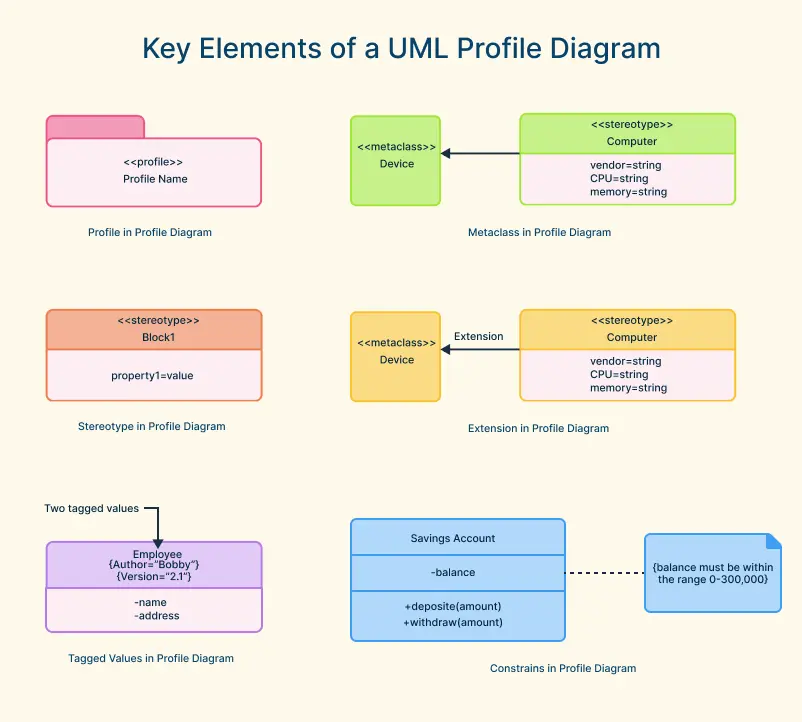A UML Profile Diagram is a powerful tool for customizing standard UML models to fit specific domains, from IT management and enterprise software to mobile applications and service-oriented architectures. By using UML profiles, teams can define domain-specific stereotypes, tagged values, and constraints, all while keeping their models compatible with standard UML tools. In this guide, we’ll break down the key elements of a UML profile diagram, show you how to create one step-by-step, and explore ready-to-use templates to accelerate your modeling workflow.
UML Profile Diagram Definition
A UML Profile Diagram is a specialized type of UML diagram used to customize and extend the Unified Modeling Language (UML) for specific domains or platforms. It allows modelers to define domain-specific elements, such as new symbols, stereotypes, and tagged values, without altering the standard UML structure.
In simple terms, a UML profile diagram helps adapt UML to fit specialized modeling needs. For instance, software engineers might use UML profiles to model embedded systems, data architectures, or real-time software, while system engineers use them to represent system-level designs with industry-specific notations.
By using a profile diagram, teams can represent domain concepts more accurately and maintain consistency across complex projects. These diagrams are commonly used in software modeling, systems engineering, and model-driven development, where flexibility and precision are essential.
When to and Why Use a UML Profile Diagram
A UML Profile Diagram is essential whenever teams need domain-specific extensions without compromising the integrity or compatibility of the standard UML metamodel. By encapsulating domain rules and specialized constructs, profile diagrams simplify onboarding for new team members and ensure consistent modeling practices across the organization.
1. Industry-Specific Modeling
Complex sectors such as automotive, finance, and healthcare often require specialized modeling elements. For example, an automotive UML profile might include stereotypes like <<ECU>> (Electronic Control Unit), while a finance-focused profile could define <<Transaction>> or <<Ledger>>. Using a profile diagram, these domain-specific elements are standardized so that all stakeholders, from architects and developers to auditors, share a common vocabulary and visual notation.
2. Maintaining UML Standard Compliance
Rather than modifying core UML metaclasses, UML profiles layer extensions on top of the standard UML metamodel. This approach preserves tool interoperability and adheres to the OMG UML specification (OMG 2.3), ensuring that your models remain portable and compatible across different UML tools.
3. Avoiding Metamodel Changes That Break Tool Compatibility
Direct alterations to UML’s core classes or packages can make models unreadable in standard UML software. By using profile diagrams, organizations can safely extend UML in a reversible, non-intrusive way, maintaining cross-tool collaboration and long-term maintainability.
4. Ensuring Clear Documentation and Governance
Centralizing UML profiles in a managed registry with version control enables organizations to maintain audit trails and standardized modeling practices. Governance policies can enforce approved profiles, making training, compliance, and model validation much simpler.
Key Elements of a UML Profile Diagram
A UML Profile Diagram consists of a few key building blocks that make it possible to tailor UML to specific domains. These elements, stereotypes, tagged values, and constraints, work together to extend the semantics of standard UML diagrams. Each plays a distinct role in defining how a profile diagram operates within customized UML profiles.

Profiles
A profile is the top-level container in a UML profile diagram that defines a set of domain-specific extensions to the standard UML language. It organizes stereotypes, tagged values, and constraints into a cohesive package that can be applied to UML models. Profiles allow teams to customize UML for particular industries, technologies, or projects while maintaining compatibility with standard UML tools.
Stereotypes
Stereotypes are the foundation of UML profiles. They allow you to create new model elements derived from existing UML components, such as classes, components, or associations. By applying stereotypes, you can introduce domain-specific terminology and behaviors without changing the UML metamodel.
For example, in a software architecture profile diagram, you might define stereotypes like <<Service>>, <<Controller>>, or <<Entity>> to represent key architectural roles. These stereotypes help modelers communicate intent clearly and maintain consistency throughout the design.
Metaclasses
Metaclasses are the standard UML elements that can be extended within a profile. They represent the building blocks of the UML metamodel, such as Class, Component, Interface, or Association, and act as the base elements to which stereotypes are applied. By targeting specific metaclasses, profiles can precisely define how domain-specific concepts integrate with standard UML diagrams.
Tagged Values
Tagged values are used to add custom properties or metadata to UML elements. They provide additional context that standard UML elements don’t include. For instance, a <<Database>> stereotype could have tagged values like storageType = SQL or replication = enabled.
By attaching tagged values, UML profiles become more descriptive and adaptable to complex modeling scenarios, enabling teams to embed configuration or operational data directly into the model.
Constraints
Constraints define the rules or conditions that must be satisfied within a UML model. They are used to ensure the model adheres to domain-specific standards or system requirements. Constraints can be expressed informally using natural language or formally using languages like OCL (Object Constraint Language).
In a profile diagram, constraints help validate the correctness of applied stereotypes and tagged values. For example, you can specify that a <<Service>> stereotype must only connect to a <<Controller>> stereotype, ensuring logical consistency in the system design.
Extensions
Extensions define the relationship between a stereotype and the UML metaclass it modifies. They show how domain-specific elements in a profile diagram enhance or customize standard UML components without altering the core metamodel. For example, a <<Entity>> stereotype might extend the Class metaclass, indicating that all classes labeled with this stereotype follow specific domain rules or carry additional properties. Extensions are essential for illustrating how UML profiles integrate custom semantics with standard UML diagrams.
Together, these elements form the backbone of any UML profile. They make the profile diagram a powerful way to create domain-specific modeling environments that enhance clarity, reusability, and accuracy in system representation.
How to Create a UML Profile Diagram
Creating a usable UML profile diagram is a deliberate, iterative process. Below is a clear step-by-step workflow you can include in your guide; each step includes practical tips and copy you can drop into the article to help readers follow along.
Step 1: Identify the Domain and UML Metaclasses
Start by defining the problem space: what domain (e.g., healthcare, IoT, finance) are you modeling and which UML metaclasses (Class, Component, Interface, etc.) will be extended. Document the key concepts and the concrete elements in your domain that don’t map cleanly to vanilla UML.
Quick tips: List 5–10 domain concepts, map each to a UML metaclass, and capture why they need a custom stereotype.
Step 2: Define Stereotypes and Tagged Values
Create stereotypes to represent domain roles (for example <<Device>>, <<Sensor>>, <<RegulatoryArtifact>>). For each stereotype, define tagged values, structured metadata that carry configuration or business data (e.g., latencyLimit, complianceLevel). Keep stereotypes small and purpose-driven.
Quick tips: give each stereotype a one-line definition and 2–4 tagged values; include examples in your profile diagram legend.
Step 3: Create Relationships and Constraints
Model how stereotypes relate (generalization, association, dependency) and add constraints to enforce domain rules. Use natural-language constraints for readability and OCL (Object Constraint Language) for formal validation where needed. Example constraint: “A <<PaymentProcessor>> must be associated with at least one <<BankGateway>>.”
Quick tips: Draw simple relationship examples next to each stereotype; keep constraints testable.
Step 4: Visualize and Validate Your Profile
Render the profile diagram visually and run validations: check that stereotypes map to the intended metaclasses, tagged values are typed, and constraints don’t conflict. Create one or two example model instances that use your profile to prove it works (a “hello world” use case).
Quick tips: Include a small profile diagram example (one-page) and a paired model instance to show real usage.
Step 5: Use Creately to Draw Your UML Diagrams Easily
Adopt a collaborative modeling tool so your UML profiles and profile diagrams are versioned, shareable, and editable by stakeholders. Provide templates, export options, and documentation alongside the model so developers and architects can apply the profile consistently.
Quick tips: Publish a template, add a short usage guide, and invite domain experts to review the profile.
Free UML Profile Diagram Templates
To make creating UML profile diagrams faster and more consistent, using ready-to-use templates is highly effective. Templates provide a structured starting point with predefined stereotypes, tagged values, and constraints, so teams can focus on modeling their specific domain rather than building everything from scratch.
Here are some practical UML profile diagram templates you can use for different domains and purposes:
1. Basic UML Profile Diagram Template
A clean and simple template to get started with UML profiles. Includes core stereotypes, tagged values, and example constraints suitable for general-purpose modeling. Ideal for beginners or for building foundational profiles.
2. UML Profile Diagram Example for IT Management
Designed for IT and enterprise architecture, this template includes stereotypes like <<Server>>, <<Database>>, and <<Service>> with associated tagged values. Useful for modeling IT infrastructure, workflows, and service interactions.
3. Android Mobile Platform UML Profile Diagram
Tailored for mobile app development, this template provides domain-specific stereotypes such as <<Activity>>, <<Service>>, and <<BroadcastReceiver>>. Tagged values allow developers to capture properties like permissions, API levels, or resource usage.
4. UML Profile Diagram Example for EJB Application
Focused on Enterprise JavaBeans (EJB) systems, this template includes stereotypes like
<<SessionBean>>, <<EntityBean>>, and <<MessageDrivenBean>>. It helps software architects document enterprise applications with clear, domain-specific modeling constructs.
5. SoaML (Services) UML Profile Diagram Example
Built for service-oriented architecture modeling, this template supports the SoaML standard with stereotypes like <<ServiceInterface>>, <<ServiceContract>>, and <<Participant>>. Tagged values and constraints allow teams to define service-level agreements, endpoints, and dependencies.
Benefits of Using UML Profile Diagrams
Using a UML profile diagram offers several advantages for teams working on domain-specific modeling, making it an essential tool for complex projects.
1. Enhanced Expressiveness
Profile diagrams extend standard UML with domain-specific concepts, allowing you to model real-world scenarios more accurately. By adding custom stereotypes, tagged values, and constraints, your UML diagrams become more descriptive and aligned with the specific needs of your project.
2. Improved Communication
Customizing UML with a profile ensures that all stakeholders—developers, architects, and business analysts—share a common modeling language. This alignment reduces misunderstandings and makes discussions about system design more precise and actionable.
3. Tool Support and Automation
When profiles are applied, modeling tools can recognize and support domain-specific constructs. This enables advanced features such as validation, code generation, and simulation, improving workflow efficiency and reducing errors in model-driven engineering projects.
4. Consistency and Reusability
Profiles help standardize modeling practices across projects or even entire organizations. By defining reusable stereotypes and tagged values, teams can maintain consistency and leverage previous work in future projects, saving time and effort.
5. Flexibility and Adaptability
Organizations can adapt UML to meet evolving project requirements or industry standards by modifying existing profiles or creating new ones. This ensures that UML profile diagrams remain relevant and useful as systems and domains change over time.
Creating a UML Profile Diagram allows teams to model complex systems clearly, enforce domain-specific rules, and maintain UML standard compliance, all without reinventing the wheel. Whether you’re designing IT infrastructure, mobile platforms, or enterprise applications, using ready-made UML profile templates can save time and improve collaboration. Start building your own UML profiles today with Creately’s UML Diagram Software and see how easy it is to visualize, customize, and share your domain-specific UML diagrams.
FAQs About UML Profile Diagrams
What is the difference between a UML profile diagram and a standard UML diagram?
How do I create a UML profile diagram for a new domain?
Can UML profile diagrams be reused across multiple projects?
What industries benefit most from using UML profile diagrams?
<<ECU>>), finance (e.g., <<Transaction>>), healthcare (e.g., <<MedicalRecord>>), and software development (e.g., <<Service>>). UML profile diagrams provide a standardized way to capture domain-specific concepts visually.





